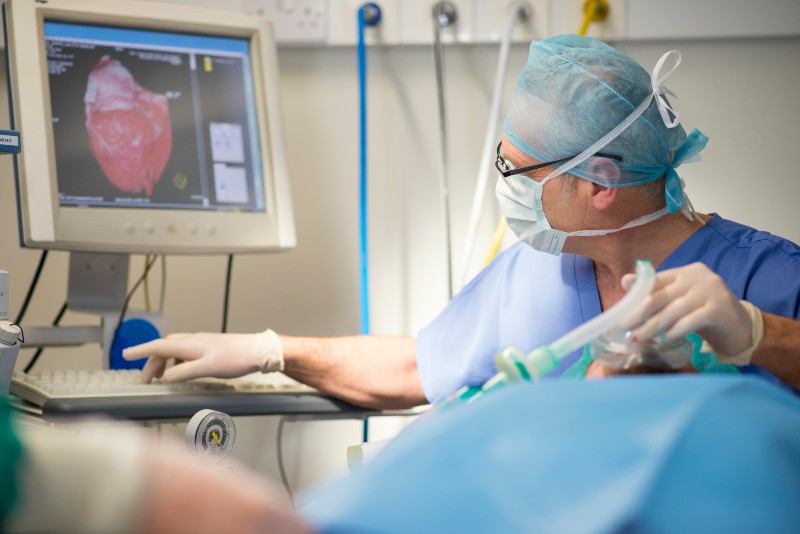Thoracic Aortic Aneurysms
Treatment of Thoracic Aortic Aneurysm in Sun City, Glendale, and Peoria, AZ
The aorta is the largest artery in the body and is located in the chest. A thoracic aortic aneurysm is a bulge, swelling, or rupture of that artery. The condition is caused by a weakening of the aortic wall, and symptoms may be minor, may get worse over the years, or may cause major complications. At Cardiac Solutions, our experienced, board-certified cardiologists specialize in thoracic aortic aneurysm diagnosis and treatment. Call us to schedule a consultation to assess your condition and explore your treatment options for a thoracic aortic aneurysm in Sun City, Glendale, or Peoria, AZ.
What Is a Thoracic Aortic Aneurysm?
A thoracic aortic aneurysm is a cardiac condition that occurs when the aorta develops a bulge. This can happen when the wall of the aorta becomes weakened due to plaque, disease, or genetic factors. In some cases, patients don’t experience any symptoms. In other cases, the symptoms may appear and gradually worsen over time. If the aneurysm ruptures, it can cause a medical emergency or death.
Differences Between Thoracic & Other Types of Aneurysms
An aneurysm is a bulge or swelling in the wall of a blood vessel that occurs when there is a weakening of the wall of the blood vessel. Aneurysms can occur anywhere in the circulatory system but most often occur in the brain and aorta. The most common types of aneurysms are:

- Abdominal – An abdominal aortic aneurysm occurs in the lower part of the aorta. It develops when the aorta becomes enlarged at the level of the abdomen and can be life-threatening if it bursts. The condition is most common in smokers and older men, and the aneurysm develops slowly without obvious symptoms. Before it ruptures, you may develop back, stomach, or side pain.
- Aortic – An aortic aneurysm is a bulge in the aorta. The bulge may be round or tube-shaped and can occur due to trauma, complications from a medical condition, or a genetic condition that has weakened the walls of the aorta. Without treatment, the aneurysm can rupture or split and cause internal bleeding or organ damage. Symptoms include sudden pain in the stomach or back, loss of consciousness, dizziness, increased heart rate, trouble breathing, shock, clammy skin, and pale or gray skin.
- Brain – A brain aneurysm or cerebral aneurysm is a weakening of a blood vessel in the brain that puts pressure on the nerves and tissues. Small aneurysms may not cause symptoms, but large aneurysms can cause pain behind the eye, a dilated pupil, vision changes, and numbness on one side of the face. If the aneurysm ruptures, it can cause stroke, brain damage, coma, or death.
- Peripheral – A peripheral aneurysm is a weakened or enlarged artery that forms outside of the aorta or the brain. They commonly occur in the legs or neck and can cause pain, cramping, a pulsating feeling, swelling, numbness, ulcers, gangrene, and sores on the fingers or toes.
- Thoracic – A thoracic aortic aneurysm forms in the aorta as it passes through the chest. It is caused by a weakening of the aortic wall. Symptoms can include pain in the jaw, neck, chest, or back, coughing, wheezing, or shortness of breath, hoarseness, loss of consciousness, and a sudden drop in blood pressure.

Thoracic Aortic Aneurysm Causes & Risk Factors
The most common cause of a thoracic aortic aneurysm is plaque buildup in your arteries or atherosclerosis. This buildup can weaken the walls of the aorta over time. The biggest risk factors for a thoracic aneurysm are:
- Smoking
- High blood pressure
- A sedentary lifestyle
- Obesity
- Poor diet
- Family history or genetics
- Age
- Coronary artery disease
- Bicuspid aortic valve disease
- Health conditions like Loeys-Dietz syndrome, Marfan syndrome, Turner syndrome, and vascular Ehlers-Danlos syndrome
Thoracic Aortic Aneurysm Symptoms
Many people don’t ever experience symptoms of a thoracic aortic aneurysm. When people do experience symptoms, they may develop gradually and worsen over time.
The most common symptoms are:
- Jaw pain
- Neck pain
- Chest pain
- Upper back pain
- Difficulty swallowing
- Hoarseness
- Coughing or wheezing
- Shortness of breath
If the aneurysm ruptures, symptoms include:
- Sudden severe chest or back pain
- Lightheadedness
- Dizziness
- Loss of consciousness
- Heavy sweating
- Confusion
- Trouble speaking
- Disorientation
- Rapid heart rate
- Vision loss
- Weakness or paralysis on one side of the body
Diagnosis & Screening of Thoracic Aortic Aneurysms
We can screen you to determine your risk of an aortic aneurysm. Genetic mutations can increase your risk, but they don’t guarantee that you will develop one. We can diagnose an aortic aneurysm by assessing your symptoms, lifestyle, and health history and running diagnostic tests like a chest X-ray, CT angiogram, echocardiogram, magnetic resonance angiogram, or abdominal ultrasound.
Thoracic Aortic Aneurysm Treatment Options
The most common and effective way to treat the condition is with thoracic aortic aneurysm surgery. We will determine if you need surgery based on your symptoms, age, overall health, the size and location of the aneurysm, how quickly it is growing, and any underlying conditions.
Why Choose Cardiac Solutions
Cardiac Solutions is a team of experienced cardiologists who serve patients in Peoria, Sun City West, Glendale, Sun City, Litchfield, Avondale, Phoenix, and Wickenburg. We focus on preventive treatment and highly personalized cardiovascular treatment plans. We can help patients manage their symptoms, reduce their risk of complications, and improve their quality of life.
Book an Appointment with Cardiac Solutions
Call us today or contact us online to schedule a consultation with one of our board-certified cardiologists in Sun City, Glendale, or Peoria, AZ. We can run diagnostic testing to determine if you have a thoracic aortic aneurysm or perform screenings to assess your risk level.
